Last week, on a trip out West, I had the opportunity to visit the Stewart Filmscreen factory in Torrance, California. In addition to hearing about new products and new screen formulations from executives, I and some fellow journalists were taken on a tour of the facilities to see exactly how these high-end projection screens are created.
Founded in 1947, Stewart Filmscreen is still a family-owned and operated business, with a son and three grandsons of the founder still at the helm. They've expanded from their original facility in Torrance, California to offices and manufacturing facilities in Ohio, Denmark and Singapore. But the Torrance facility is still their home and headquarters. With projection screens ranging in price from about $1,950 to over $125,000, Stewart's products are aimed squarely at the high end consumer and professional market. So what's involved in making one of these screens and are they worth the expense? I'm glad you asked.
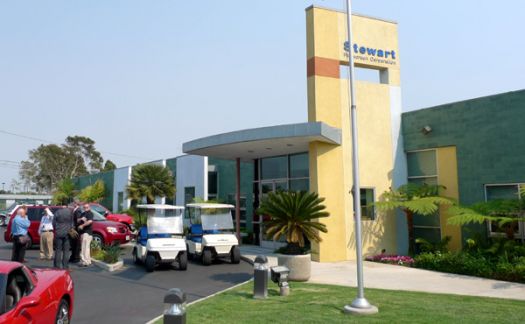
What surprised me most about Stewart's manufacturing and assembly process was the fact that nearly every step is performed by hand or at least overseen by skilled craftsmen with years of experience. Of course, there is also some advanced technology involved, namely the high tech chemistry and manufacturing process that leads to the various screen formulations. Stewart also utilizes automation where appropriate, such as the robotic sprayers that slowly plod their way along tracks in an enormous room, spraying layer upon layer of Stewart's secret sauce into giant molds in order to form the actual screens. This proprietary process and facility allow Stewart to make some truly gigantic seamless screens -- up to 40 feet by 90 feet -- with nearly perfect screen uniformity across their entire surface.
A Screen is Born
Stewart screens begin life as a powdery resin which is combined with a flame retardant solvent and mixed into a viscous liquid that has the consistency of maple syrup. Pigments and rare earth elements are added in order to come up with the specific Stewart screen formulations such as the popular StudioTek 130, the Silver 3D formulation, and the new StudioTek 100 -- a pure matte white unity gain screen. This last one is a new screen formulation that Stewart execs say is ideal for the latest crop of high-end ultra-accurate projectors used in a dedicated home theater environment where excessive ambient lighting is not a factor.
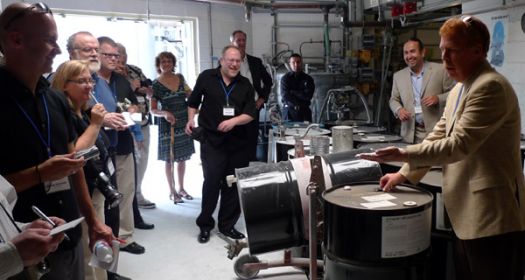
The batches of liquid screen gunk then make their way into the spraying rooms, where layers of substrate material are followed by layers of optical coating which then dries to form the finished screen. After carefully peeling it from its mold, the screen is then cured until it reaches is optimum physical characteristics, in terms of flexibility and longevity. Screens that are destined for the perforators (machines which punch tiny holes in order to let sound pass through from rear-mounted speakers), are cured an additional few days in order to reach the level of rigidity needed to support perforation without stretching or stressing the screen material. In a nod to efficiency and environmental friendliness, the screen curing room's heat is provided naturally as a byproduct of the factory's waste disposal incineration system.
Testing, Testing
Quality control is clearly of utmost importance to the folks at Stewart and this carries through all stages of the manufacturing process. After each batch of screen material is removed from the mold, a sample is cut and brought to their in-house testing lab where the optical properties are verified to make sure they meet tightly controlled specifications. Screen uniformity, gain and chromatic properties are all verified and recorded for each screen batch. The roll of material is also visually inspected (with a high-powered loupe, no less) to make sure they cut around even the tiniest of imperfections or inclusions. This way the final cut/manufactured screens are as close to perfect as they can be.
Holy Cow!
For those individuals and theater owners who want their speakers elegantly tucked away behind the screen, Stewart offers perforated screens which allow sound to pass through transparently while still reflecting light back to produce an image. The Cinema Perforator (CinemaPerf) machine is used for screens 14 feet or taller in height while the Micro Perforator (MicroPerf) machine is used for screens below 14 feet in height.
In order to prevent moiré patterns from appearing on the screen, Stewart measures each new projector that comes on the market, so they can determine an ideal skew pattern for the perforations. Stewart then cuts the screen at an angle to meet the optimal skew pattern for the specific projector. Using a swatch of CinemaPerf'ed screen material, Don Stewart demonstrated that we could hear his voice clearly and naturally through the perforated screen.
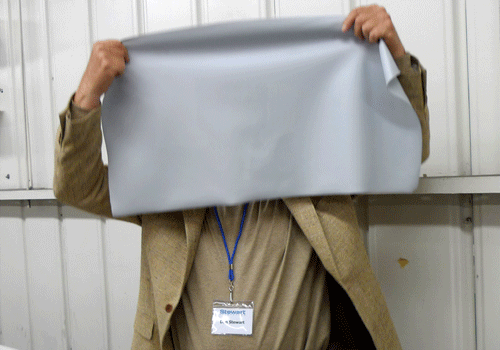
The CinemaPerf machine punches 6,000 holes per square foot while the MicroPerf machine punches a whopping 30,000 hole per square foot. Even with all these holes, the screen is perfectly capable of reflecting light back to the viewer, as about 90% of the screen material is still intact after the holes are punched. The MicroPerf machine is so precise with tolerances so fine that it requires service approximately every six months, replacing each of the 7,500 tiny pins and recalibrating the machine at a cost of over $100,000.
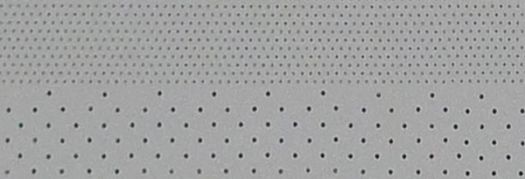
Cut!
In another room in the sprawling Stewart complex, raw pieces of screen are finished into motorized or manually drawn roll-up screens. I watched in amazement as three seasoned Stewart employees (with nearly 60 years of combined experience with the company) carefully measured, taped and hand-cut the screen materials into a finished screen. In an orchestrated ballet of complementary actions, the three workers positioned industrial strength double-sided tape, weights, micro-tabs, and cord to lower and raise the screen from the mount. One cut the screen edges precisely with a pair of scissors, while another affixed the weighted end to the screen bottom and the other affixed the tabs and tied off the cords. And all this took just a few short minutes.
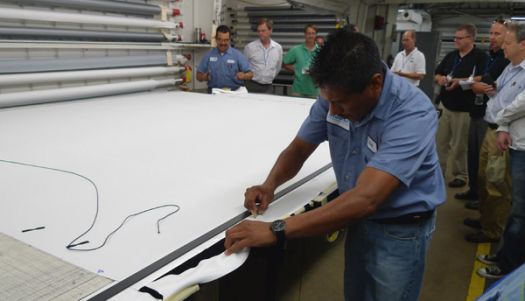
Rolling!
After being trimmed and with black masking material applied or hand-painted on, the screens are then rolled onto hollow anodized aluminum tubes, light yet sturdy and designed to house the motors with built-in heat sinks to help dissipate heat . This design helps to extend the motor life and enhance operation. "We have to anodize each piece of aluminum to prevent pitting that would otherwise occur over time in humid environments," explained Vice President Don Stewart, grandson of the founder. "Pits in the roller material would end up distorting the screen with dimples and other irregularities." In yet another bit of attention to detail, the screen roller has a lip which is exactly the thickness of the screen. This ensures an even surface to roll/unroll the screen, further contributing to a perfectly uniform and flat screen surface which maintains its uniformity over time.
A Better Black Box
Stewart's innovative approach to manufacturing extends beyond the screens and into the screen housings. For the massive screen housings which need to be suspended far above audiences and performing artists, Stewart has two rules: make 'em strong and make 'em light. To this end, they use aluminum bracing and frame materials with stiff foam core panels in between. While foam core may be more expensive, it's less than a tenth the weight of the MDF used by their competitors. Don Stewart demonstrated the effect of this by single-handedly lifting a 25-foot long, 6-inch square screen housing. This lightweight design makes it less likely that the customer will need to add structural reinforcement to their building, just to accommodate the screen. It also helps make things safer for those below.
Special Orders Don't Upset Us
One of our final stops on the tour was Stewart's Custom Shop, inspired by Fender (did I mention, the Stewart family is comprised of a bunch of motorcycle-riding musicians?). In the custom shop we got to see some of the more extreme products ordered by Stewart partners and customers. In this room, sawhorses supported all manner of high-end custom-crafted screen assemblies such as those in the "Director's Choice" series. Director's Choice screens offer customized automated masking systems for dynamic reconfiguration of the screen's aspect ratio to support the content (e.g., 1.77:1, 1.85:1, 2.4:1, etc.).
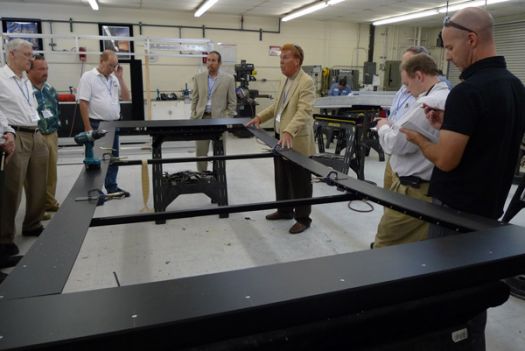
One large CineCurve screen undergoing final assembly will soon be on display at the CEDIA Expo (September 9-13 in Atlanta) where a certain projector maker will be showing off 3-D on the large screen. And the largest screen in the shop measured in at a whopping 13 feet by 23 feet, for installation in a private residence (Did someone say something about a recession? I didn't think so).
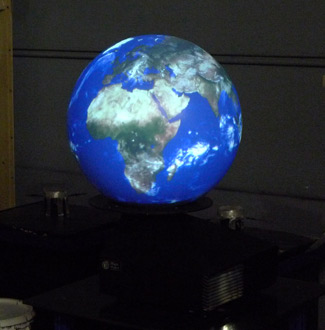
Stewart had a finished version of one of these on active display, part of a large order for the Chinese education market where the globes will be used for (among other things), global maps. While one might imagine it would be simpler and cheaper to use printed metal globes for this purpose, when you think about how often the borders and country names on the planet are changing, maybe it makes sense to update these in mapping software which is then projected into this "virtual globe," rather than scrap a printed metal globe entirely to print an updated version.
All in all, the Stewart Filmscreen factory tour provided fascinating insight into what it takes to make a high performance projection screen. From the initial mixing of chemicals to the final shipping of the screen to your door Stewart applies equal amounts of innovative engineering, expert craftsmanship and good old-fashioned TLC. Whether you're putting a projector in your basement home theater or into a commercial performance venue or high-end theatrical screening room, Stewart screens should be high on your list.
More Information and Related Articles:
Where to Buy Stewart Screens